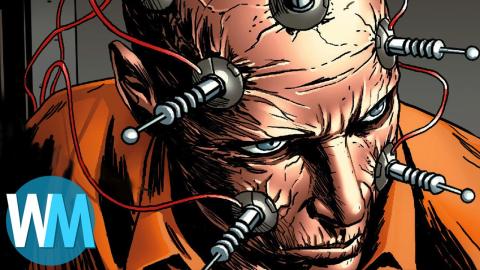Supervillain Origins: The Thinker

This dude puts the “power” in “brainpower.” Welcome to WatchMojo.com and today we will explore the comic book origin of the villain known as the Thinker.
Have an idea you want to see made into a WatchMojo video? Check out our suggest page at http://WatchMojo.comsuggest and submit your idea.
As with most comic book characters, there are often re-imaginings and different versions to a character’s past. We have chosen primarily to follow the storyline which unfolded in 1943’s All-Flash #12 and which was expanded upon in 1961’s Flash #123, 2000’s JSA #16, 2005’s Firestorm #13, and 2014’s Suicide Squad #25 and #29.
The Thinker was just a really, really smart guy when he debuted in the 1940s. But in later years he got connected with a “thinking cap” which turned out to be a bright idea. This device magnified his own smarts while at the same giving him forms of mental superpowers, such as telekinesis and mind control.
When the Thinker, AKA Clifford DeVoe, premiered in the pages of “All-Flash #12,” he was actually kind of a good guy. As a matter of fact, he was a district attorney prosecuting a crime czar by the name of Hunk Norvick. When Norvick blackmailed a key witness into lying on the stand, DeVoe’s case fell apart – and he fell to pieces. Deciding crime was the logical next step in his career, he offered his services to Norvick. Their deal was simple: Norvick would keep him on a sizable retainer. DeVoe would use his brains to come up with scenarios to help Norvick out of a jam – and Norvick would be allowed to use him for assistance one time.
Then, after the Flash captured two members of Norvick’s gang and convinced them to rat on their boss, Norvick was forced to take DeVoe up on his offer. Using an incendiary bomb, he destroyed the thugs’ confession, and then gunned them down.
Norvick, worried that DeVoe might use his brains to take over, decided to take him out. But DeVoe expected this and tricked Norvick into killing himself. DeVoe, naturally, took over Norvick’s gang and decided to keep outsmarting the Flash. When The Flash foiled one of The Thinker’s robbery attempts, the villain retaliated by trying to make Flash think his dimwitted buddies, Winkly, Blinky and Noddy, were crooks. Luring him into his trap, the Thinker used his wiles to try to destroy the Flash – but the speedster was too fast for him. The villain conceded defeat and was taken away to jail.
The Thinker returned several times in the 1940s, but a notable change occurred in his first Silver Age appearance. He was one of the three villains in the milestone “Flash of Two Worlds” story from 1961, in which the Barry Allen Flash teamed up with the Golden Age Flash, Jay Garrick.
In this story, the Thinker had somehow come into possession of a marvelous “thinking cap,” which took his already-considerable intellect to a new level. It also enabled him to exercise his mental powers on a new level, via telekinesis and mind control.
Interestingly, the Thinker didn’t create that thinking cap, but seems instead to have stolen it. It had originally appeared in a 1945 Flash story – but as the creation of an entirely different character.
Over the years, the Thinker’s costume and thinking cap underwent some big changes, making him appear more like a typical costumed supervillain. He also ended up dying – once as a member of the Suicide Squad, and once as an old man who’d become friends with Jay Garrick late in life. The discrepancy is likely related to the mass-retcons post-Crisis on Infinite Earths. But in any event, after his death, Mr. Terrific integrated his thinking cap technology into the Justice Society of America’s computers to make it more powerful. Unfortunately, this led to the creation of an Artificial Intelligence version of the Thinker who managed to take control of the JSA’s technology and became a dangerous foe.
Yet another version of the Thinker popped up in 2005, but this time he had only a slight connection to Clifford DeVoe. Cliff Carmichael had long held a deep-rooted hatred for Ronnie Raymond, who became one half of the superhero Firestorm. After he came across the Thinker’s original designs, he modified them to make himself even more powerful – and briefly took on the mantle of the Thinker.
Finally, the Thinker got a new makeover as part of the New 52 revamp of the entire DC line. In the new version, the thinking cap was gone. In its place were node attached to his skull. This version of DeVoe had been a murderer since childhood, and had suffered greatly as a result of his genius intellect; it sapped his body’s energy, so that though he was only in his 20s, his body was that of a man in his 70s. He managed to transfer his mind into the body of OMAC, a humanoid machine created for death and destruction. Didn’t work out, though.
The Thinker has had some limited exposure in the past in DC’s animated universe. He’s an interesting villain with a ton of potential, and his role as a major Flash villain in the CW TV series will inevitably and considerably raise his profile.

